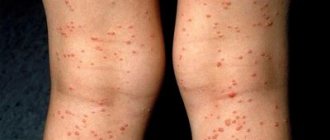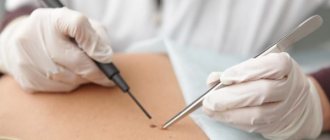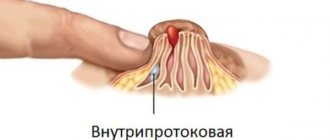Dermatologist reveals the truth about treating papillomas in pregnant women
Papillomas grew on the body.
For example, on the neck or armpit. It would seem, what’s so terrible? Just a few skin growths.
However, few people know that papillomas are symptoms of the human papillomavirus, or HPV for short. This is the name of a group of viruses consisting of more than 100 species.
HPV is widespread among the world's population. According to statistics, up to 80% of people of sexually active age become infected with the human papillomavirus at least once in their lives. It is transmitted through direct contact, often during sex. Even using condoms does not completely protect against infection.
Pregnant women are always wary and worried when it comes to viruses. And this is correct - the situation obliges you to play it safe and learn as much as possible about the disease.
However, it is too early to sound the alarm.
Most types of HPV cause discomfort only due to the appearance of the neoplasm itself. It looks ugly and constantly bumps into something. Moreover, they usually appear when the immune system is weakened. Not too pleasant, but not at all deadly. Many people live with papillomaviruses for years and do not suspect it.
Unfortunately, not all HPVs are equally harmless.
There are also dangerous exceptions. Highly oncogenic papillomaviruses lead to the formation of cancer cells. We are talking about HPV types 16, 18, 31, 33, 35, 39, 45, 51, 52, 56, 58, 59.
These viruses cause cancer of the cervix, genitals, anus and throat. Cancer cells grow slowly—sometimes decades pass before a person gets sick.
It is impossible to independently determine what type of HPV you have. For this purpose, laboratory tests are carried out.
Even if you find yourself with papilloma, do not panic. Perhaps we are talking about oncogenic HPV, perhaps about ordinary ones. Get tested and wait for the results. If you are unlucky and are diagnosed with the dangerous 16th or 18th type of papillomavirus, you will still have time to prevent the appearance of cancer. After all, now you know about the problem, and it will not be able to strike you on the sly.
Now there are many methods for removing papillomas. Laser treatment of tumors is especially popular.
But before you run to get rid of them, we advise you to get examined by a doctor. It is always useful to obtain specialist consent for surgery. In addition, it will help you find out how dangerous your tumors are.
But what if you are pregnant and want to be cured of HPV? Is it necessary to remove papilloma during pregnancy?
These questions concern many women who are preparing to become mothers.
Don’t worry, in the vast majority of cases, papillomaviruses do not affect the baby’s development in any way. Pregnant women with papillomas do not need special care.
However, if pregnant women develop papillomas, we recommend informing your gynecologist about this. He will decide whether you need to take additional tests to determine your HPV type.
Medical research shows no link between human papillomavirus and pregnancy complications. The likelihood of transmitting the virus to a child is very low.
As you can see, there is no particular need to remove papillomas in pregnant women.
Even if the patient has developed tumors of high oncogenic risk, the doctor usually postpones treatment until the baby is born.
During pregnancy, papillomas on the genitals sometimes bleed and increase in size due to hormonal imbalance. Sometimes fresh new growths appear next to them. If they can interfere with childbirth, the doctor removes them surgically.
It is easier to remove papillomas on other parts of the body during pregnancy. This procedure is not dangerous. But we recommend talking to your doctor first or waiting until the baby is born so as not to expose him to unnecessary stress.
How is the human papillomavirus transmitted: what is the danger?
Everyone should know how the human papillomavirus is transmitted. This is the only way to protect yourself from dangerous diseases. Often, papillomas are not given much importance. Many people believe that if a growth appears on the body, it will disappear on its own. This mistake haunts humanity, and the consequences may be undesirable.
Papilloma tissue tends to grow, which leads to the spread of papillomavirus throughout the body. Sometimes its individual strains can cause cancer.
What is human papillomavirus
This virus is a chronic infectious manifestation of various diseases that can appear in a person at any age. In medical practice, this virus comes in two types: one that does not carry a high risk of dangerous diseases, and a virus with a high risk.
The papilloma virus multiplies on the skin and its mucous membranes. As a result, the following growths form on the skin:
- warts;
- condylomas;
- papillomas in the mouth and larynx;
- papillomas on internal organs.
Many cases have been recorded in which papillomas become the cause of cervical cancer in women, as well as cancer of the male genital organs. To avoid such consequences, it is necessary to know about the routes of transmission of the disease.
How does the virus enter the human body?
The infection spreads through the mucous membrane or skin of a person. If there are no acute diseases, then papilloma does not manifest itself in any way, and growths do not form on the surface of the skin.
If growths of different colors have formed on the skin, then this indicates a precancerous condition, when the human skin, and the entire body, suffers a malignant disease, or the immune system is significantly reduced.
The “favorite” place for bacteria to penetrate are cuts, scratches and other skin lesions through which the virus can penetrate. The likelihood of infection increases if:
- A person has colds or other reasons for which immunity is greatly reduced.
- Dysbacteriosis of the intestines or female genital organs is observed. In this case, the beneficial microflora dies and is replaced by harmful microorganisms, in this case, papillomavirus infection.
- Presence of sexually transmitted diseases.
- Relapse of chronic diseases.
- Stress and depression, which reduce a person’s defense against viruses.
Most often, people suffering from nicotine addiction, as well as women taking birth control pills, get sick.
How the virus spreads
If a person has no symptoms, this does not mean the papilloma virus is absent. The initial stage, when there are no growths yet, can be diagnosed using the latest equipment. In medicine, there are several ways through which dangerous microorganisms are transmitted.
Both men and women can become infected with the dangerous virus. The following transmission methods are distinguished:
Sexually
This is the most common way to become infected. Just one sexual encounter, and the papillomavirus can be transmitted from an infected person to a healthy person.
Many people are interested in the question of whether papillomavirus is transmitted from woman to man. Most often, the disease is diagnosed in men, however, a large number of women can become carriers of the disease. In this case, the location of the bacteria becomes the genitals or the mucous membrane of the oral cavity, where genital warts appear. In this case, there is a 100% risk of infection.
Predisposing factors for the disease are:
- early onset of sexual activity;
- frequent change of sexual partners;
- condylomas or warts that the sexual partner has.
Reproducing in the mouth, in the absence of qualified treatment, there is a high probability of developing throat cancer. To avoid such consequences, you must use a condom.
If the localization of the virus is human skin, then a condom will not help. Papilloma is transmitted from direct contact with human skin on which condylomas and warts are located.
By everyday means
In this case, infection occurs in the following ways:
- Sharing the same towel, soap and other personal hygiene products with a person who has condylomas on their hands. Pathology occurs if there are injuries and abrasions on the body.
- Using the same toothbrush or utensils leads to infection through the patient’s saliva.
- The clothes of an infected person can also become a hotbed for the development of the virus and be transmitted to a healthy person.
- Self-infection through shaving, hair removal and other methods. The disease develops if a wart, which previously did not pose any danger, is damaged with a razor or other object. If damaged, this growth provokes the development of neoplasms, which can pose a significant danger to human health.
Infection in public places through contact with infected people
Medical practice has recorded cases where the virus was transmitted through blood transfusions, operations to remove condylomas, when doctors accidentally spread the source of infection throughout the body, and poor sterilization of manicure instruments in salons.
Mother-to-child transmission of the virus
Human papilloma is not a hereditary disease, however, the risk of transmission from mother to child still exists. When carrying a child, the risk of transmitting the virus is minimal, but still, if the placenta is damaged or other changes occur, papilloma can spread to the unborn baby.
The virus will reach him through the placenta, since the fetus has not yet formed bronchi and alveoli. In this case, the child develops respiratory papillomatosis. If after the birth of the baby he experiences breathing problems, then an examination is carried out, after which medication or surgery may be prescribed. The latter option is used much more often, as it has a greater chance of cure.
Therefore, when planning a pregnancy, it is necessary to undergo all the necessary tests to eliminate the risk of developing papilloma.
There is a very high probability that the child will become infected with the virus when passing through the birth canal. The consequence is the appearance of genital warts in the child’s mouth and larynx, which leads to various disorders of the respiratory system and decreased immunity.
If papillomas were detected in the woman’s genitals before giving birth, the birth is carried out artificially to reduce the risk of infection of the child.
Another way to infect a child from the mother is through breastfeeding. In this case, the child develops respiratory papillomatosis, which must be treated immediately.
Features of the virus in men and women
In women, the virus enters through the cervix, rectum or oral cavity. If there is a frequent change of sexual partners, the risk of infection increases to its maximum. The consequences of the disease can be infertility, cancer and many other ailments.
The papillomavirus in men most often manifests itself on the scrotum, head of the genital organ, anus or oral cavity. In men, the disease can occur without symptoms; only after severe stress or decreased immunity can the development of papillomavirus occur.
A dangerous aspect of HPV in men is the development of cancer of the male genital organs or anus.
In order to prevent the virus from entering the human body, it is necessary to follow the rules of hygiene, as well as lead a healthy lifestyle and be faithful to one sexual partner.
Is it possible to remove papillomas while breastfeeding?
This is a very interesting question. As you already know, HPV is transmitted through direct contact. It is reasonable that young mothers worry about viruses entering the baby’s body through breast milk.
And how dangerous is it to breastfeed if you have the human papillomavirus?
Yes, there is a danger. As we have already said, some types of HPV cause cancer of the uterus and genital organs. But the benefits of breastfeeding outweigh these risks. There is not a single medical organization that recommends stopping breastfeeding due to papillomavirus.
Breastfeeding is beneficial because it:
- Reduces the likelihood of chronic diseases such as diabetes.
- Reduces the risk of certain types of cancer.
- Accelerates the development of the child.
- Protects the baby from infections.
- Reduces the risk of heart disease.
All modern research shows that the likelihood of transmitting HPV from mother to child through breast milk is extremely low.
Therefore, you don’t have to worry that your baby will get papillomavirus while breastfeeding. Remove warts only after consulting your doctor. This way you will be sure that the treatment will not harm you or your child.
Now we will tell you how getting rid of papillomas in a clinic differs from going to a dubious beauty salon.
Papillomas during pregnancy
The appearance of papillomas during pregnancy not only causes women physical and mental discomfort, but also makes them worry about a potential threat to the baby.
For a woman, pregnancy is, unfortunately, not only a joyful anticipation of the baby, but also anxiety about the changes occurring in the body. Thus, against the background of hormonal changes, viruses may become more active, the presence of which the woman did not even suspect.
An example of this is papillomas during pregnancy: expectant mothers often note the growth of existing tumors and the appearance of new ones. Of course, this causes some concern, since unsightly growths not only become an unpleasant cosmetic defect, but also indicate the presence of the human papillomavirus in the body; you can learn more about it in our article “Human Papillomavirus”.
Is it necessary to undergo treatment for this virus before giving birth? Is it worth removing tumors during pregnancy or is it better to postpone this procedure until the end of the gestation period? We will try to answer all these and other questions of concern to expectant mothers in this article.
Causes of papillomas during pregnancy
The main factors causing the growth and appearance of tumors are:
1. Decreased immunity. During pregnancy, the female body directs all resources to the formation of the fetus. Because of this, the level of immunity often decreases and various viruses and infections that previously did not manifest themselves are activated. This happens with the human papillomavirus, which, in conditions of reduced immunity, causes the appearance of various types of skin tumors; more details about them are written in the article “Growts on the skin: benign, malignant and borderline.”
2. Hormonal changes, under the influence of which epidermal cells in certain areas of the body can begin to rapidly divide and form papillomas.
3. Chronic skin injury. During pregnancy, it is very important to choose clothes and shoes taking into account the changes occurring in the body. Wearing tight shoes during swelling, constant squeezing and friction of the skin also provoke pathological changes.
4. Diabetes mellitus in pregnant women.
Most often, papillomas are concentrated on the neck and chest, in the armpits, but can appear on any part of the body, even to the genital mucosa. And although the very presence of these neoplasms causes discomfort, they do not pose any danger to the newborn: the fetus in the uterus is reliably protected from infection. However, there is a risk of contracting HPV from the mother during passage through the birth canal. The most severe manifestation of this disease in newborns is the development of papillomas on the mucous membrane of the respiratory tract, but these cases are extremely rare in clinical practice. Most often, the child’s body successfully resists viruses.
Treatment of papillomas in pregnant women
While carrying a child, a woman should avoid any potentially dangerous manipulations and procedures. Therefore, if papillomas do not cause obvious physical discomfort, do not become inflamed and remain painless, doctors do not recommend removing them before the baby is born. Another argument in favor of waiting is the random drying out of some tumors when hormonal levels stabilize after childbirth and breastfeeding.
If the papillomas are located in an area that is constantly subject to friction and compression, become inflamed, and bleed, then doctors recommend removing them using one of the modern methods. Pregnant women are offered several methods to choose from:
- cryodestruction;
- surgical removal;
- laser removal of papillomas
and others.
The use of laser is considered the most progressive achievement in cosmetology today. The directed energy of a laser beam in many cases turns out to be much more effective than cryodestruction, and the process of treating a tumor is much less painful than in the case of surgical removal.
The procedure is carried out using modern laser systems, which allow you to constantly monitor the depth, intensity and area of impact. During the procedure, the beam evaporates overgrown epidermal cells layer by layer, leaving healthy skin without damage. The treatment area is covered with a small crust, which comes off after a few days, leaving no scars or scars.
How tumors are removed
The benefits of laser removal of papillomas also include:
1. Painless. Laser removal during pregnancy is recommended as a method that does not cause physical discomfort to the woman. The treatment is performed under local anesthesia, for which safe drugs are used in carefully selected concentrations.
2. Bloodlessness. The capillaries in the treatment area are instantly sealed, so laser manipulation is not accompanied by bleeding.
3. Disinfectant effect. Under the high-temperature influence of the laser beam, bacteria and viruses located in the treatment area die.
4. Sterility. Manipulations are carried out remotely, without direct contact with the skin, so there is no risk of tissue infection.
5. Anti-relapse effect. Since laser removal of papillomas from the surface of healthy skin evaporates all cells of the neoplasm, the likelihood of its reappearance is excluded.
Indications and contraindications for laser removal of papillomas
The indication for this procedure is the presence of tumors on any part of the body if their presence causes discomfort. Contraindications include:
- inflammatory and infectious skin diseases;
- allergic dermatitis
and some other cases.
You should consult your doctor about the possibility of using this technique during pregnancy.
The healing period of the treatment area is only a few days, during which a crust forms on the skin, which spontaneously falls off after complete tissue regeneration. For two weeks before and after treatment, it is not recommended to sunbathe, visit a solarium, or injure the papilloma.
Accurate diagnosis and quality treatment versus quick and cheap removal of papillomas
Although some types of HPV cause cancer, many people ignore them.
“Well, just think, several skin tumors. I’ll go to a beauty salon and quickly remove them,” that’s what they think.
Not everyone wants to go to a medical center to get rid of papillomas. This is why such people often have problems with incomplete removal of tumors or even complications due to improper treatment of papillomas.
You will avoid these troubles if you remove the papilloma in the clinic.
If you absolutely need to get rid of a tumor, contact experienced dermatologists.
Removing a papilloma on the vocal cord, mouth or lip is very difficult. You definitely don't want to go through this procedure twice. But if the operation is unsuccessful, then you will have to pay for the removal of the tumor again
Therefore, we recommend making an appointment with a medical doctor.
Our doctors will carefully review your medical history and ask additional questions. Then they will examine the papillomas that are bothering you. Dermatologists will check all suspicious tumors with an electronic dermatoscope Delta 20 T. This device helps to detect the degeneration of tumors in the early stages.
Our doctors remove papillomas on the face, neck, chest, mouth and other parts of the body. Make an appointment with dermatologists at the Lasersvit clinic and they will get rid of tumors in 1 session.
Do you want to know how much this procedure costs?
Now we will try to answer this question.
Is it worth removing papillomas on the face and neck and how can this be dangerous?
Probably, almost every person in childhood had a wart on their fingers or was bothered by a purulent boil, stye on the eyes, or herpes on the lips prevented them from eating normally. And some people are literally covered with papillomas on their face and neck. Why do they come out in such unexpected places? And it’s all due to the herpes virus and human papillomavirus, which once infected cannot be cured. The insidious virus is “prescribed” in the body for life and can be asymptomatic for years, without making itself felt.
And as soon as the immune system weakens, the body weakens, feels a lack of vitamins, lives under the influence of chronic fatigue, stress, it immediately manifests itself in the form of warts, papillomas and herpes. We talked about this in more detail with Marina Afanasyevna Vyguzova, an infectious disease specialist at the Yakutsk Medical Center.
— In childhood, we all got warts, so how do you know that a person is a carrier of the herpes virus?
— At the KVD you can get tested for HSV (herpes simplex virus) and HPV (human papillomatosis virus). A smear from the genital tract is taken for the herpes simplex virus using PCR diagnostics. Moreover, herpes can be localized not only on the genitals, but also in other places. The human papillomavirus, of which there are many classifications, is determined through blood from a vein using the ELISA method.
— What is the difference between herpes and papilloma?
— Papillomas, soft round-shaped formations that are attached to a stalk, quickly grow on the face, neck, armpits, and sometimes on the genitals, they appear only on the skin of a person, and herpes in severe cases can be localized on the internal organs. In the carrier, the existence of this virus in the blood is most often asymptomatic, if the body’s immune defense is sufficient to prevent its excessive activation.
- If the test is positive, they say it remains for life and is not treated, is it really so hopeless?
— It all depends on the titers, if the titer is small, then this is considered a carrier state, and if the disease has external manifestations and the titer is high, then symptomatic treatment is prescribed. Unfortunately, it is not possible to remove the virus from the body; the antibodies remain, the titers simply decrease. If a person’s immunity is good, the virus can remain dormant for a long time and not manifest itself in any way. Therefore, you need to take care of yourself and not catch a cold, because when a person is sick with ARVI or acute respiratory infections, influenza, sore throat, this is the first alarm bell about reduced immunity. Even if you are sick and feel chills, you do not need to endure body aches on your feet, drinking antipyretic drugs and going to work. By doing this you only oppress and suppress the functioning of the immune system. In the first week, you need to stay at home, lie down under a warm blanket, drink plenty of fluids and allow the immune system to fight infection and eliminate viruses. We need to train the body to resist diseases; the capabilities of the immune system are limitless. Remember, living in the same house with a sick person, not all family members suffer from tuberculosis. Also, in past centuries, not all people during the plague fell ill with cholera, smallpox, etc. Those who had good immunity remained.
— Why is carriage of HSV and HPV dangerous?
— HPV primarily reduces reproductive function in women, in some cases even to the point of infertility.
— How is the herpes and papilloma virus transmitted: domestically or sexually?
— The human papillomavirus is spread through household contact, just like chickenpox and measles. And some types of herpes can be transmitted sexually.
— They say that some strain of HPV can be oncogenic and provoke the development of cancer, is this true?
— The human papillomavirus has become widespread throughout the world. According to medical statistics, about 90% of the population are carriers of one type of papilloma virus. Modern medicine has described over 70 varieties of this infection, causing various diseases of the mucous membranes or skin. HPV includes varieties of warts, including plantar warts. Only some of them are classified as a precancerous condition. You can find out about this by taking an HPV test.
— If a wart or papilloma comes out, how to react correctly: cauterize it, or go to a doctor, which one?
— Papillomas and warts are not aesthetically beautiful, therefore, before removing or cauterizing them, you need to go to a dermatologist to find out their nature and prescribe proper treatment.
— Marina Afanasyevna, thank you for the conversation!
ICNL Press Service
How to find out the cost of tumor removal
You have decided to get rid of papillomas. Because they cause inconvenience, or because of the risk of developing cancer. Perhaps you just don't like the way they look on your face.
In any case, now you need to choose a method for eliminating papillomas. This question has a lot to do with how much it costs to remove a papilloma.
Unfortunately, we cannot give the exact amount.
The cost of the operation depends on many factors. For example, it is associated with the location of tumors. Naturally, it is easier to remove papilloma in the armpit than in the mouth.
The clinic will tell you the exact price after examining the tumors and measuring them.
How many papillomas can be removed at one time?
Modern methods make it possible to immediately get rid of many tumors. The doctor removes one in 1-2 minutes. If there are a lot of them, it will take 30-40 minutes to cleanse the skin.
Let's return to the methods of removing papillomas. Here are the 5 most popular:
- Electrocoagulation
The doctor applies electric current to the tissue. Due to the high temperature, papillomas are destroyed, but adjacent areas of the skin are also damaged. This is a cheap procedure, but after it the wound takes a long time to heal. There are cases where patients were injured.
- Radio wave removal
The dermatologist acts on the papilloma with high-frequency radio waves. The neoplasm is destroyed from the inside, while the surrounding tissue remains intact. The patient does not feel pain. The wound heals quickly and leaves no marks.
- Cryodestruction
The papilloma is treated with liquid nitrogen. It turns white and the patient does not feel this area of skin. The neoplasm quickly dies. The wound heals completely in 5-6 weeks. No anesthesia is provided during the operation.
- Laser removal
The doctor burns the papilloma with a laser beam. A wound remains in its place, which heals in 3-4 weeks. Healthy skin is not damaged. This procedure is excellent for removing growths on the eyelids, throat and other delicate areas.
- Removal with a scalpel
The operation is performed to remove large papillomas. It is performed under local anesthesia. Along with the tumor, the doctor cuts off some healthy tissue. He puts stitches on the wound and removes them after 7 days.
As you can see, you have a wide choice among methods for removing papillomas. While you are thinking about which one is best for you, we will talk about caring for distant tumors.
Price block








